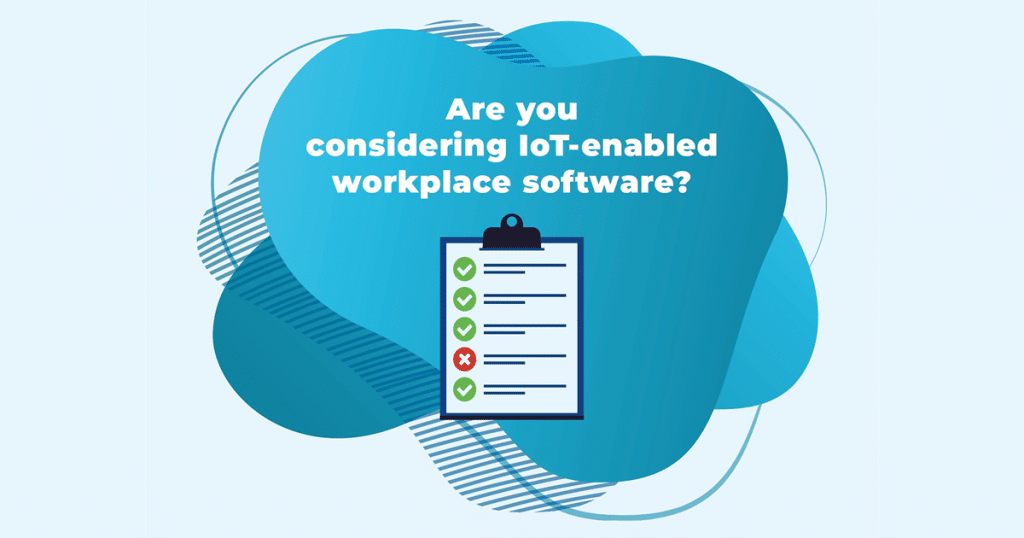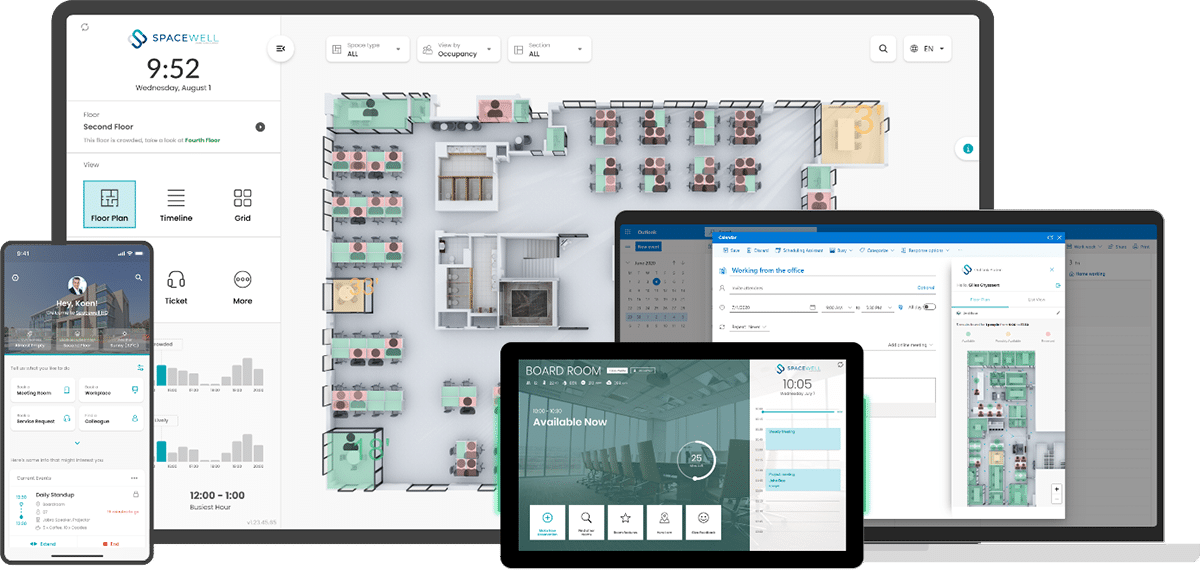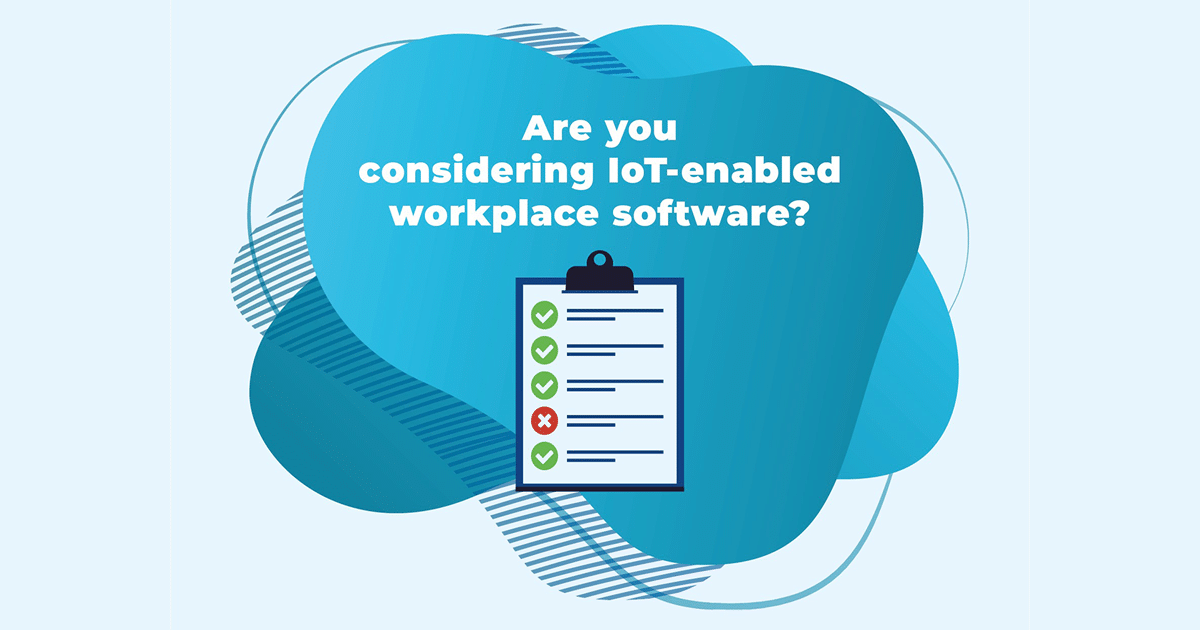As a result of the pandemic, building managers and workplace teams are faced with a challenging situation. Not only are they confronting enormous uncertainties around building occupancy and usage patterns, but they are also challenged by employees who now expect more from their experience in the workplace. To deal with these new realities, businesses have a need for workplace software solutions that are more connected, mobile and smarter than traditional FM software (aka IWMS).

Free checklist
Essential Tips for Choosing a Smart Workplace IoT Solution
Far far away, behind the word mountains
Integrating across IWMS and IoT to create a smart workplace
Hence the arrival on the market of more advanced solutions that augment traditional IWMS with live data from the IoT. IoT technologies can generate troves of real-time data about space usage and environmental factors like humidity and temperature. They have the potential to vastly enhance IWMS. And they enable facility, real estate, and workplace managers to optimize space, make services more efficient, and provide a frictionless workplace experience. But not every IoT-enabled smart workplace software platform is born equal. Cloud-first, open & integrated platform architecture is a key factor to unlocking value. But there are a number of other considerations that determine whether a solution will live up to your expectations. These include capabilities such as advanced analytics, 3rd party connectivity, quality of the user interface, and mobile applications.

Essential Tips for Choosing a Smart Workplace Software Solution
Are you considering IoT-enabled smart workplace software?
Here are some do’s and don’ts to facilitate the selection process and avoid the pitfalls.
Your Use Case(s)
Start with the end in mind. What use cases do you want to enable? Is that also the focus of the IoT solution you are considering?
Don’t go for a solution whose capabilities are not a great match with your key focus areas.
Independent Assessments
Check out benchmarks and recommendations from independent consulting firms (such as the 2022 Verdantix Green Quadrant IoT Platforms for Smart Buildings report).
Don’t make your shortlist based only on vendor marketing claims.
Data Capture
Choose a hardware-independent (aka datapoint-agnostic) platform, that can ingest data from different types of sensors, BMSs, etc.
Avoid vendor lock-in with sensor manufacturers that only offer their own hardware (this often goes hand in hand with limited analytical capabilities).
Data Processing
A good IoT solution is built from the ground up as a cloud-native ‘big data’ platform, that can process large and complex data sets.
Avoid simple workplace software and point solutions that offer sensors ‘on the side’. These can be limited to very basic use cases. And they will likely fall short when having to analyze and interpret IoT big data.
Analytics
At its core, a workplace IoT solution is about the actionable insights it provides. You’ll need advanced analytics features that enable you to click through the data, find correlations, and understand root causes. Ask vendors to demo dashboards relevant to your business cases, such as for example space optimization.
Don’t settle for traditional dashboards that show aggregated data in a static way. These may look nice but don’t offer much value.
Integration
Much of the value of IoT-enabled smart workplace software lies in leveraging real-time data to make processes smarter and improve the employee experience. Make sure to choose a single-platform solution that natively integrates IoT with workflow-based processes.
Don’t go for 2 separate solutions (IWMS and IoT) that are poorly integrated.
Mobility
You’ll need a workplace app that shows real-time data on interactive floor plans, on a smartphone and other touchscreens. This greatly improves the workplace experience and enables more efficient service delivery.
Don’t choose smart workplace software that fails to maximize the value of real-time sensor data for building users and service providers.
Interoperability
An IoT solution comprises several components such as gateways, sensors, cloud, and software that must communicate and share data to form a network. No single vendor can deliver it all. Make sure to choose a solution that works with all major standards and devices and connects to external systems via standard APIs.
Avoid a patchwork of solutions that introduces compatibility problems where technologies from different vendors cannot communicate or share data with each other.
Security
Only use thoroughly tested, secure, and reliable sensors (ask your vendor about their certification process).
Use end-to-end encrypted wireless technology (for example, the standardized LoRa open-source protocol).
Operate the IoT applications separately from the corporate IT network and data (no use of corporate WiFi either).
Use a fully encrypted and segregated data processing platform such as the Workplace SaaS solution, that benefits from the advanced security features of public cloud infrastructure.
Lack of adequate security measures is a common problem for IoT (and smart building platforms using it). Don’t get dragged into an internet of risky things, that makes you vulnerable to cyber-attacks
Privacy
Opt for technology that monitors the performance of the work environment, not of the people using the spaces.
Make sure there’s an opt-in mechanism for showing personal data (for example, I allow colleagues to see my current location in the office).
Choose a solution that is fully GDPR-compliant and allows to easily aggregate or anonymize (IoT) data that can be directly or indirectly traced back to an individual.
Don’t install sensors without explaining how people will benefit, what data is collected, and how the data will be used.
SaaS
Choose a cloud-first SaaS solution that offers public cloud-based best practices, instant scaling & elasticity, enhanced performance and stability, and improved uptime. You only pay for what you use and get frequent, automatic updates so that you always benefit from the latest capabilities. Also, look out for the option to install sensors as-a-service (HaaS). You pay a set monthly fee (no up-front capital investment) and can more easily stay current with advances in sensor technology.
Legacy systems won’t allow you to scale up (and down) quickly and effectively. Updates are infrequent and may come with some issues. This leads to many businesses working on older software versions that do not offer them the latest and greatest features.









